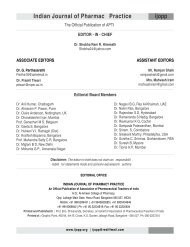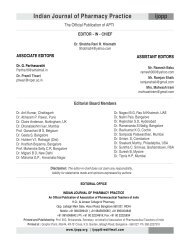<strong>Indian</strong> J. Pharm. Pract. 1(2), Jan-Mar, 2009potential cost savings quantified arose only from the This findings correlates with the multicentre prospectiveintervening pharmacist-initiated interventions. The2study conducted in Australia which showed a reductionpotential cost savings arose from other activities carried <strong>of</strong> $1 50 307 due to decrease in length <strong>of</strong> stay as a result <strong>of</strong>out by the intervening pharmacist such as drugtheir intervention in eight major acute care hospitals. Theinformation, patient medication counseling, monitoringdifference in the magnitude <strong>of</strong> reduction in healthcareand managing adverse drug events were not consideredexpenditure due to reduced length <strong>of</strong> stay may beand quantified. In addition, the total time spent by theexplained by the fact that their study was conducted on aintervening clinical pharmacist to address the DRPs was106 hours and 25 minutes. If the intervening clinical large-scale population in eight acute care governmentpharmacist had spent more time in reviewing patients' funded hospitals.drug therapy, it would have resulted increased potential The potential for probability <strong>of</strong> readmission wascost savings. Moreover, the cost savings due to prevented in 13 cases and that resulted in cost savings <strong>of</strong>intervention quantified in our study were a direct link to INR: 9079.85. This finding differs with the Michael J.utilization <strong>of</strong> specific health resources. Although some2Dooley et al study wherein the cost saving was found topatients experienced other health outcome benefits from be $111848. There were no interventions on medicalthe interventions done by the intervening clinical procedures that resulted in cost savings and only fourpharmacist, these outcomes were not quantified ininterventions had impact on laboratory monitoring thateconomic terms. Reduction in drug cost accounted forresulted in cost savings amounting to INR: 476.20. Inthe majority <strong>of</strong> the cost-benefit measured. It is obvious2Michael J. Dooley et al study the expenditure onthat increased number <strong>of</strong> drug use without indication andimproper drug selection increases the unnecessary druglaboratory monitoring was $ 4558 and cost savings oncost. Therefore, by intervening in these types <strong>of</strong> DRPs laboratory monitoring was accounted for $ 4 213.clinical pharmacist can contribute to reduction inIn our study, the annualized cost savings due to clinicalunnecessary healthcare expenditure arising due to use <strong>of</strong> pharmacist-initiated changes to drug therapy was foundunnecessary medications. The total drug cost saved due2to be Rs: 46,686.08. In Michael J. Dooley et al study, theto clinical pharmacist interventions was INR: 13,708.75 reported annualized saving was $ 4 444 794. Thewhile increase in drug cost accounted for Rs: 1621.75. difference in the annualized cost savings between theseThis increased drug cost observed in our study was two studies is due to fact that variation in the studymajority due to untreated indication such as anemia,population and number <strong>of</strong> hospitals included in the study.cough and vomiting. Although, addition <strong>of</strong> drug in these 2Michael J. Dooley et al study was conducted at eightcases led to increase in treatment cost, patient would havemajor acute care hospital with well trained andbenefited in terms <strong>of</strong> therapeutic outcome. However, thenet drug cost savings was INR: 12,087. Savings <strong>of</strong> drugexperienced pharmacist. But, our study was conduced in2cost was also observed in Michael J. Dooley et al studya single tertiary care teaching hospital and also thewherein the cost savings accounted for $8 279 while the intervening pharmacist was a postgraduate clinicalincreased drug cost accounted for $ 7964. Our study pharmacy student with minimal experience on drugfindings reveal that the clinical pharmacist's intervention therapy reviewing and managing DRPs. Other reasonsis one <strong>of</strong> the effective cost saving measures, and clinical might be due to differences in the cost <strong>of</strong> drugs,pharmacists should enforce their attitude towards cost laboratory tests, hospital stay charges etc between theeffective patient management.study sites.Increased length <strong>of</strong> stay has been consistently associatedNevertheless, clinical pharmacist initiated changes towith drug related problems like inappropriate drugdrug therapy resulted not only the cost savings but alsoselection and subtherapeutic dose. Interventions <strong>of</strong> theseassociated with improved patient outcome. The overallDRPs would certainly result in reduction in the patients'observation made from this study was that pharmacistshealthcare expenditure. In our study, the reduction <strong>of</strong>treatment cost due to reduction in length <strong>of</strong> stay was have greater responsibility in healthcare team inestimated to be INR: 5905.50 while two <strong>of</strong> the minimizing and/or preventing drug related problems andinterventions had increased the length <strong>of</strong> stay thereby thereby can potentially reduce the unnecessary hospitalincreasing the healthcare expenditure by INR: 315.00. stay, readmission, laboratory monitoring and drug cost.44
<strong>Indian</strong> J. Pharm. Pract. 1(2), Jan-Mar, 2009CONCLUSIONOur study demonstrates that the physicians' acceptancerate <strong>of</strong> pharmacist-initiated changes in drug therapy ishigh. Clinical pharmacist's review <strong>of</strong> in-patients drugtherapy can positively influence the patient outcomesand reduce healthcare costs. This proves the fact thatclinical pharmacist has an enormous role to play in thehealthcare management through quality use <strong>of</strong>medicines.ACKNOWLEDGEMENTWe would like to thank the Principal, Staff andPostgraduate students <strong>of</strong> Department <strong>of</strong> <strong>Pharmacy</strong><strong>Practice</strong>, JSS College <strong>of</strong> <strong>Pharmacy</strong>, Mysore, and the Staff<strong>of</strong> Department <strong>of</strong> Internal Medicine and AdministrativeStaff <strong>of</strong> JSS Medical College Hospital, Mysore for theirsupport and encouragement.REFERENCES1. Salvesen Blix Hege, Viktil Kirsten K, ReikvamAsmund, Anders Moger Tron, Jahren Hjemaas Bodil,Piia Pretsch et.al. The majority <strong>of</strong> hospitalized patientshave drug-related problems: results from a prospectivestudy in general hospitals. Eur J Clin Pharmacol 2004;60: 651-658.2. Dooley Michael J, Allen Karen M, DoeckeChristopher J, Galbraith Kirsten J, Taylor George R,9. Helper Charles D, Strand Linda M. Opportunities andresponsibilities in pharmaceutical care. American<strong>Journal</strong> <strong>of</strong> Hospital <strong>Pharmacy</strong> 1990; 47:533-534.10. Olesson Sten, Parthasarathi G. Adverse drugreactions. In: Parthasarathi G, Nyfort-HansenKarin,Nahata Milap C. A textbook <strong>of</strong> clinical pharmacystpractice. 1 ed. Orient Longman Private Limited;2004: 84-102.11. Stebbins Marilyn R, Kaufman David J, LevensLipton Helene. The price clinic for low-incomeelderly: a managed care model for implementingpharmacist-directed services. <strong>Journal</strong> <strong>of</strong> ManagedCare <strong>Pharmacy</strong> 2005; 11:333-341.12. The Society <strong>of</strong> Hospital Pharmacist <strong>of</strong> Australia(SHPA) committee <strong>of</strong> specialty practice in clinicalpharmacy. <strong>Practice</strong> Standards: Standards <strong>of</strong> practicefor clinical pharmacy. The Society <strong>of</strong> HospitalPharmacist <strong>of</strong> Australia 1996; 2-16.13. Dell Kale MO, Kuoukarelan Suzan. Impact <strong>of</strong> theclinical pharmacist on readmission in patients withacute coronary syndrome. The Annals <strong>of</strong>Pharmacotherapy 2005; 39: 1432-1427.14. Whaley DL, Tomich DJ, Kelly PC, Tanner J,Mahnke CB. Impact <strong>of</strong> clinical pharmacist-ledguideline enforcement on drug costs, patientsatisfaction. Formulary 1999; 34: 257-268.15. Lusting Ahuva. Medication errors prevention bypharmacist- an Israeli solution. <strong>Pharmacy</strong> WorldBright Jennifer et.al. A prospective multicentre study Science 2000; 22(1): 21-25.<strong>of</strong> pharmacist initiated changes to drug therapy and 16. Bantar Carlos, Sartori Beatriz, Vesco Eduardo, Heftpatient management in acute care government funded Claudia, Saul Mariano, Salamone Francisco et.al. Ahospitals. British <strong>Journal</strong> <strong>of</strong> Clinical Pharmacology hospital wide intervention program to optimize thequality <strong>of</strong> antibiotic use: impact on prescribing2004; 57(4): 513-521.practice, antibiotic consumption, cost savings and3. Parthasarathi G, Ramesh M, Kumar JK, Madaki S.bacterial resistance. CID 2003; 37:180-186.Assessment <strong>of</strong> drug-related problems and clinical17. Caspi Alan, Rozenfeld Vitalina, Kleyman Jennie.pharmacists' interventions in an indian teachingPrevention <strong>of</strong> medication errors in the hospitalhospital. <strong>Journal</strong> <strong>of</strong> <strong>Pharmacy</strong> practice and Researchsetting: the role <strong>of</strong> pharmacy students. <strong>Pharmacy</strong> and2003; 33: 272-274.Therapeutics 2005; 30: 183-186.4. Einarson Thomas R. Drug-related hospital admission.The Annals <strong>of</strong> Pharmacotherapy 1993; 27: 832-840.5. Roberts Michael S, Stokes Julie A, King Michelle A,Lynne Teresa A, Purdie David M, Glasziou Paul Pet.al. Outcomes <strong>of</strong> a randomized controlled trial <strong>of</strong> aclinical pharmacy intervention in 52 nursing homes.British <strong>Journal</strong> <strong>of</strong> clinical pharmacology 2000; 51:257-265.6. Strand LM, Morley PC, Cipolle RJ, Ramsey R,Lamsam GD. Drug related problems-their structureand function. The Annals <strong>of</strong> Pharmacotherapy 1990;24:1093-1097.7. Bond CA, Raehi Cynthia L, Franke Todd. Medicationerrors in united states hospitals. Pharmacotherapy2001; 21(9): 1023-1036.8. Kaleemudin Mohammed, Sankham Rajendran D,Bojaraj Suresh. The role <strong>of</strong> clinical pharmacist inpoison- related admission in a secondary carehospital. Australian <strong>Journal</strong> <strong>of</strong> <strong>Pharmacy</strong> 2001; 31:26-30.45
- Page 1: Indian Journal of Pharmacy Practice
- Page 4 and 5: Indian Journal of Pharmacy Practice
- Page 7 and 8: APTIIndian J. Pharm. Pract. 1(2), J
- Page 10 and 11: Indian J. Pharm. Pract. 1(2), Jan-M
- Page 12 and 13: Indian J. Pharm. Pract. 1(2), Jan-M
- Page 14 and 15: APTIijoppGenesis, Development and P
- Page 16 and 17: Indian J. Pharm. Pract. 1(2), Jan-M
- Page 19 and 20: Indian J. Pharm. Pract. 1(2), Jan-M
- Page 21 and 22: Indian J. Pharm. Pract. 1(2), Jan-M
- Page 23 and 24: Indian J. Pharm. Pract. 1(2), Jan-M
- Page 25 and 26: Indian J. Pharm. Pract. 1(2), Jan-M
- Page 27 and 28: Indian J. Pharm. Pract. 1(2), Jan-M
- Page 29 and 30: Indian J. Pharm. Pract. 1(2), Jan-M
- Page 31 and 32: Indian J. Pharm. Pract. 1(2), Jan-M
- Page 33 and 34: Indian J. Pharm. Pract. 1(2), Jan-M
- Page 35 and 36: Indian J. Pharm. Pract. 1(2), Jan-M
- Page 37 and 38: Indian J. Pharm. Pract. 1(2), Jan-M
- Page 39 and 40: Indian J. Pharm. Pract. 1(2), Jan-M
- Page 41 and 42: Indian J. Pharm. Pract. 1(2), Jan-M
- Page 43 and 44: Indian J. Pharm. Pract. 1(2), Jan-M
- Page 45 and 46: Indian J. Pharm. Pract. 1(2), Jan-M
- Page 47 and 48: Indian J. Pharm. Pract. 1(2), Jan-M
- Page 49: Indian J. Pharm. Pract. 1(2), Jan-M
- Page 53 and 54: pivotal to the rational use of medi
- Page 55 and 56: .leadership” (Cohen, 1984). A stu
- Page 57 and 58: Indian J. Pharm. Pract. 1(2), Jan-M
- Page 59 and 60: Indian J. Pharm. Pract. 1(2), Jan-M
- Page 61 and 62: Indian J. Pharm. Pract. 1(2), Jan-M
- Page 63 and 64: Indian J. Pharm. Pract. 1(2), Jan-M
- Page 65 and 66: Indian J. Pharm. Pract. 1(2), Jan-M
- Page 67 and 68: Indian J. Pharm. Pract. 1(2), Jan-M
- Page 69 and 70: Indian J. Pharm. Pract. 1(2), Jan-M
- Page 71 and 72: Indian J. Pharm. Pract. 1(2), Jan-M
- Page 73 and 74: Indian J. Pharm. Pract. 1(2), Jan-M
- Page 75 and 76: Indian J. Pharm. Pract. 1(2), Jan-M
- Page 77 and 78: Indian J. Pharm. Pract. 1(2), Jan-M
- Page 79 and 80: Indian J. Pharm. Pract. 1(2), Jan-M
- Page 81 and 82: Indian J. Pharm. Pract. 1(2), Jan-M
- Page 83 and 84: Indian J. Pharm. Pract. 1(2), Jan-M
- Page 85 and 86: Indian J. Pharm. Pract. 1(2), Jan-M
- Page 87 and 88: Indian J. Pharm. Pract. 1(2), Jan-M
- Page 89 and 90: Indian J. Pharm. Pract. 1(2), Jan-M
- Page 91 and 92: Indian J. Pharm. Pract. 1(2), Jan-M
- Page 93 and 94: Indian J. Pharm. Pract. 1(2), Jan-M
















